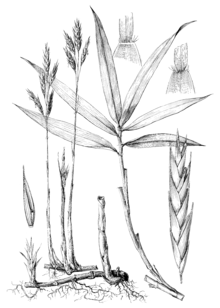Arundinaria tecta
Arundinaria tecta, or switchcane,[1] is a bamboo species native to the Southeast United States,[1][2] first studied in 1813.[3] It serves as host to several butterfly species.[4] The species typically occurs in palustrine wetlands.[5]
| Arundinaria tecta | |
|---|---|
 | |
| Scientific classification | |
| Kingdom: | Plantae |
| Clade: | Tracheophytes |
| Clade: | Angiosperms |
| Clade: | Monocots |
| Clade: | Commelinids |
| Order: | Poales |
| Family: | Poaceae |
| Genus: | Arundinaria |
| Species: | A. tecta |
| Binomial name | |
| Arundinaria tecta (Walter) Muhl. | |
Description
Arundinaria tecta is a low and slender bamboo that branches in its upper half, growing up to 0.6–4 m (2 ft 0 in–13 ft 1 in) in height. The leaves are 8–20 cm (3.1–7.9 in) long and 0.8–3 cm (0.31–1.18 in) wide, tapering in width towards their base. The panicles are borne on shoots that grow directly from the rhizomes. Each panicle has a few clustered spikelets on slender branches. These branches have loose sheaths with minute leaves. The spikelets are 2.5–5 cm (0.98–1.97 in) long and have five to ten flowers.[6]
The plant flowers from March to June.
References
- "Plants Profile for Arundinaria tecta (switchcane)". plants.usda.gov. Retrieved 2017-07-29.
- Hitchcock, Albert Spear; Chase, Agnes (1951). Manual of the Grasses of the United States. U.S. Department of Agriculture. p. 824.
Arundinaria tecta.
- Ohrnberger, D. (1999-01-29). The Bamboos of the World: Annotated Nomenclature and Literature of the Species and the Higher and Lower Taxa. Elsevier. ISBN 9780080542386.
- Scott, James A. (1992-03-01). The Butterflies of North America: A Natural History and Field Guide. Stanford University Press. ISBN 9780804720137.
- Burton Edward Livingston, Forrest Shreve (1921). The Distribution of Vegetation in the United States: As Related to Climatic Conditions. Carnegie Institution of Washington publication. 284. Carnegie institution of Washington. p. 85.
- Merrit Lyndon Fernald (1970). R. C. Rollins (ed.). Gray's Manual of Botany (Eighth (Centennial) - Illustrated ed.). D. Van Nostrand Company. p. 96. ISBN 0-442-22250-5.